
|
Feedback Form
| Summary | Basic activities | Forwards and backwards | Turning | Roamer Music |
 |
To get rid of the demonstration program press CM CM. Roamer is now ready
to be programmed.
In all the following activities it is important to clear the memory each
time before programming Roamer.
1
Sit the class in a circle, place Roamer in the centre. Show how to clear
the memory and program Roamer:
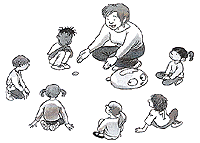 (If you have
the playing cards you can lay out the appropriate cards for them to see
which buttons you're pressing.)
(If you have
the playing cards you can lay out the appropriate cards for them to see
which buttons you're pressing.)
Place a marker at the back of Roamer, press GO and once Roamer has completed
its program, place another marker at the back of Roamer. Remove Roamer
so they can see what I unit is. Place Roamer between the two markers so
they can see that 1 unit = 1 Roamer.
Repeat this exercise asking different children to place the second marker
where they think Roamer will stop. Try starting at different locations
so that they are not using a bit of fluff on the carpet or some such oddity
to judge the distance but are really having to visualise a Roamer unit.
This exercise is crucial to begin estimating correctly. In order to understand measurement children need to know what unit is being used and for estimation they need to be able to visualise the unit.

2
Class still sitting in a circle. Place Roamer in front of a child and
ask who they would like to send it to. Point Roamer in the right direction
and ask them to estimate the distance. At this point pacing out is very
helpful. As the child paces it out the others can count the steps. Program
the Roamer accordingly.
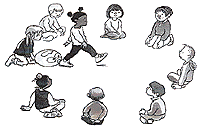 Repeat this
activity many times. The more lopsided the circle, the greater the variety
of numbers used.
Repeat this
activity many times. The more lopsided the circle, the greater the variety
of numbers used.
Number can be understood in three different ways - as defining a thing's position in a series (its ordinal nature) as a quantity (its cardinal nature) and as a symbol (number recognition). This exercise combines all these elements forming a good basis for understanding number. By pacing out and counting, children will appreciate the order of number. In order to program Roamer correctly the child has to understand the symbols for number: the distance represents the cardinal nature of number.

3
Get the children to stand in a line and make a tunnel with their legs.
The first child has to program Roamer to go all the way through the tunnel.
This can be repeated with the children standing closer together and further
apart to vary the length of the tunnel. See if they remember to pace it
out first for estimating.
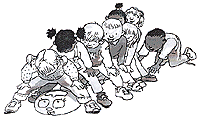
Children love this estimating activity and it provides a great opportunity to develop mathematical ideas such as before, after, longer than, shorter than, etc.

4
This activity can be done either in small groups or as a whole class activity
with the children divided into teams.
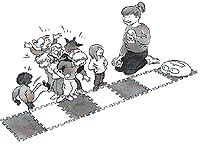 Mark a box
on the floor within which Roamer will be placed. Choose a number (pick
a Roamer playing card or throw a dice) and ask the children where they
think Roamer will stop if you program it to go forward this number of
units. If the children are playing individually they can stand where they
think it will stop, if they are playing in teams one person from each
team should stand where the team thinks it should stop.
Mark a box
on the floor within which Roamer will be placed. Choose a number (pick
a Roamer playing card or throw a dice) and ask the children where they
think Roamer will stop if you program it to go forward this number of
units. If the children are playing individually they can stand where they
think it will stop, if they are playing in teams one person from each
team should stand where the team thinks it should stop.
Once again the main feature of this activity is estimation and understanding number. It will also provide ample opportunity for language development, particularly if the children are working cooperatively in groups.

5
You can now introduce programming Roamer to go backwards. Once again,
show Roamer going back 1 so the children can visualise the unit; then
repeat the above game going backwards instead of forwards.
Introducing backwards movement is obviously important in terms of space and shape but it can also provide a foundation for understanding subtraction later on.

6
Create a number line (the Roamer floor mats are wonderful for this purpose
or it can be chalked on the floor). Using only the numbers up to five
from the Roamer playing cards or alternative, pick a card and program
Roamer to go up the number line. Leave Roamer where it is and pick another
card. Ask children where they think Roamer will stop when you put in the
new number.
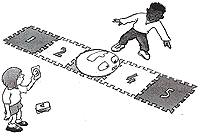 NOTE:
Remember to clear Roamer's memory (CM CM) before reprogramming with the
second number.
NOTE:
Remember to clear Roamer's memory (CM CM) before reprogramming with the
second number.
This activity clearly introduces the idea of addition and the language involved.

7
Once again start by selecting a card and programming Roamer to go up the
number line. Select a second card, and this time ask the children where
Roamer will stop if it goes backwards by this number.
This introduces subtraction and will help develop the associated language.
8
Using the Roamer playing cards or similar select the forwards and backwards
cards, shuffle and place face downwards in a pile. Select all the number
cards, shuffle and place face downwards in a second pile.
One child should take a card from each pile. They must put the cards down
in an order that Roamer will understand. Before programming Roamer they
should say where they think Roamer will stop. Then they can program Roamer
and see how accurate their estimation was.
Then the next child repeats this activity starting with Roamer where the
last child left it.
This is a wonderful reinforcement exercise on number operations. It provides plenty of opportunity for language development.